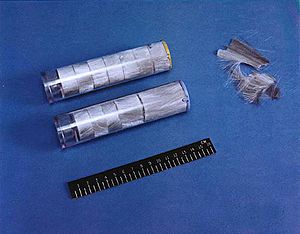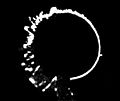Chaff (countermeasure) facts for kids
Chaff is a special tool used by the military to protect planes and ships. It's made of many tiny, thin pieces of metal. When these pieces are released from an aircraft or a warship, they create a big cloud that can confuse enemy radar. This helps keep military vehicles safe from being detected or hit by missiles.
Contents
What is Chaff and How Does It Work?
Chaff is made of very small, light pieces of metal, often aluminum or metal-coated glass fibers. These pieces are usually stored in special containers on military planes or ships. When needed, they are shot out into the air.
Tricking Radar
Radar is a system that uses radio waves to find objects. It sends out radio waves, and when these waves hit something, they bounce back to the radar receiver. This helps the military see where things are, like enemy planes or ships.
Chaff works by creating a lot of fake signals on the enemy's radar screen. When the tiny metal strips are released, they spread out into a cloud. Each little piece of metal reflects radar waves, just like a plane or ship would. This makes it look like there are many targets, or a very large, blurry target, instead of just one real one. It's like trying to find one specific person in a huge, crowded room where everyone is wearing the same outfit.
Protecting Against Missiles
Many modern missiles use radar to find their targets. These are called radar-guided missiles. If an enemy launches such a missile, a plane or ship can release chaff. The chaff cloud acts like a decoy. The missile's radar might get confused by all the false signals from the chaff and aim for the cloud instead of the actual plane or ship. This gives the military vehicle a chance to escape safely.
Chaff is a very effective way to hide from enemy radar and protect valuable military assets during conflicts.
Images for kids
-
A Lancaster dropping chaff (the crescent-shaped white cloud on the left of the picture) over Essen during a thousand-bomber raid
-
The effect of chaff on the display of a Würzburg Riese radar. The effect of jamming appears in the left "jagged" half of the circular ring, contrasting with the normal "smooth" (unjammed) display on the right half of the circle, with a real target at the 3 o'clock position – on the jammed left side the real target "blip" would have been indistinguishable from the jamming.
-
Letter from Secretary of the Navy, James Forrestal to Merwyn Bly
See also
 In Spanish: Chaff para niños
In Spanish: Chaff para niños






